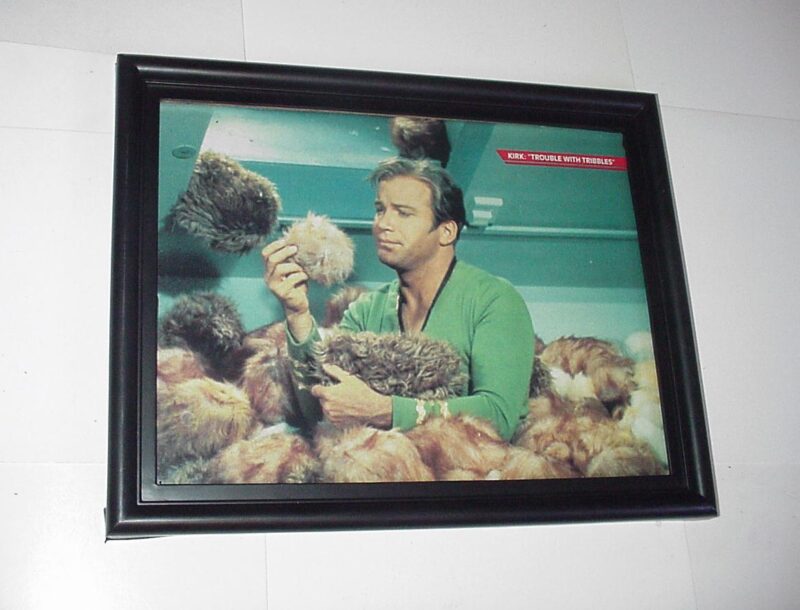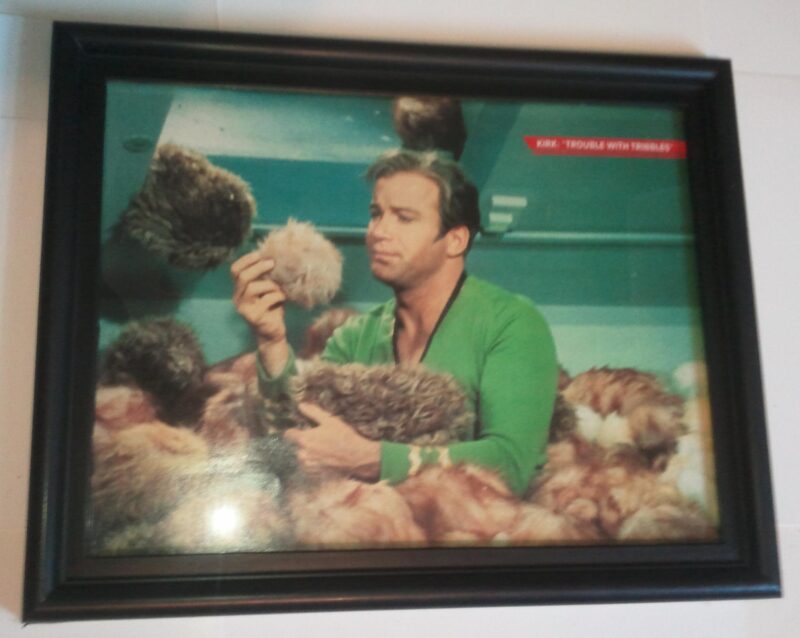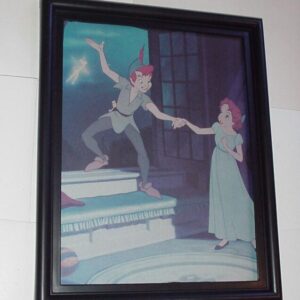Star Trek Pin-up #29 FRAMED Kirk Trouble with Tribbles William Shatner
$44.99
Description
In “The Trouble with Tribbles” the U.S.S. Enterprise travels to Deep Space Station K7 to guard a consignment of grain bound for Sherman’s Planet. On arrival, a trader named Cyrano Jones (Stanley Adams) gives Lt. Uhura (Nichelle Nichols) a tribble, with dramatic consequences. Kirk and the crew also have to deal with the arrival of Captain Koloth (William Campbell) and his Klingon battlecruiser, but the tribbles unexpectedly reveal a plot to poison the grain.
Around 1,500 tribbles were created for the episode, with special tribbles created for certain purposes with beanbags or surgical balloons inserted in them. Three additional sets were created for the episode, although there were problems with finding enough matching chairs for the trading post area. The chairs had to be pulled out of showrooms around Los Angeles County, and Pevney was warned to make sure they weren’t damaged during the episode’s brawl scene.
While initial fan reaction to the episode was mixed, it was more popular with the general public. Critical response to the episode was positive, and it was nominated for the Hugo Award for Best Dramatic Presentation which instead went to fellow Star Trek episode “The City on the Edge of Forever”. It has since been included in several “best of” episode lists and features, including as part of the Best of DVD collection alongside three other episodes.
“The Trouble with Tribbles” was intended to have a third-season follow-up episode, but it was not completed. The follow-up episode was developed for Star Trek: The Animated Series as “More Tribbles, More Troubles”. Gerrold explained that the episode was almost uncut from the original premise. To celebrate the 30th anniversary of Star Trek in 1996, the Star Trek: Deep Space Nine episode “Trials and Tribble-ations” used digital techniques to insert the Deep Space Nine actors into the events of “The Trouble with Tribbles”. Gerrold appeared on-screen as an extra, and the episode was nominated for three Emmy Awards and also for the Hugo Award for Best Dramatic Presentation.
An independent trader, Cyrano Jones (Stanley Adams), arrives on the station with some tribbles. He gives one to Lt. Uhura (Nichelle Nichols), who brings it on board the Enterprise, where it and its quickly produced offspring are treated as adorable pets. The animals purr a relaxing trill that the crew find soothing. Klingons, however, find tribbles annoying, and the feeling is mutual: tribbles hiss and shriek whenever they are near Klingons.
Doctor Leonard McCoy (DeForest Kelley) is concerned that the increasing numbers of tribbles threaten to consume all the onboard supplies. It is discovered that they are entering ship systems, interfering with their functions and consuming any edible contents present. Kirk realizes that if the tribbles are getting into the ship’s stores, then they are a threat to the grain aboard the station. He examines the holds but learns that it is already too late: The tribbles have indeed eaten the quadrotriticale, and Kirk is literally buried in grain-gorged tribbles when he opens a grain hold with an overhead hatch. Spock (Leonard Nimoy) and McCoy discover that about half the tribbles in the hold are dead and many of the rest are dying, alerting them that the grain has been poisoned.
Baris stubbornly holds Kirk responsible for this apparent fiasco, and Koloth additionally demands an apology from Kirk after some of the Enterprise crew were provoked into a brawl with the Klingons in the station’s bar. However, the tribbles incidentally give away the identity of a Klingon agent surgically altered to resemble a human: Arne Darvin (Charlie Brill), Baris’s own assistant. He had infected the grain with a virus that becomes an inert material in an organism’s bloodstream which eventually prevents the organism from taking in enough nourishment to survive.
After Darvin’s exposure and arrest, Cyrano Jones is ordered to remove the tribbles from the station (a task that Spock estimates will take 17.9 years) or he will be imprisoned for 20 years for transporting a dangerous life form off its native planet. Just before the Klingons depart, all the tribbles on the Enterprise are transported onto the Klingon vessel by Chief Engineer Montgomery Scott (James Doohan) where, in his words, “they’ll be no tribble at all.”
Writer David Gerrold was surprised one morning when he was handed a copy of the tribbles script and told to sign it for Robert A. Heinlein. It turned out that the tribbles in the episode resembled the Martian flat cats in Heinlein’s 1952 novel The Rolling Stones. Gerrold was concerned that he had inadvertently plagiarized the novel which he had read fifteen years before. These concerns were brought up by a research team, who suggested that the rights to the novel should be purchased from Heinlein. One of the producers phoned Heinlein, who only asked for a signed copy of the script and later sent a note to Gerrold after it aired to thank him for the script. The grain mentioned in the script, triticale, was a fairly new invention at the time of the episode. It had been created in Winnipeg in the early 1960s which was referenced in the episode by Spock. However, the expectations of the show in that it would be revolutionary were not realised and it was eventually used as animal feed only. This changed in 2009, the Canadian Government invested $15 million in research to find out if the grain had potential for use as a biofuel.
The inspiration for the form of the tribble instead came from a fluffy keyring owned by Holly Sherman. The design came from Wah Chang, but they were individually sewn by Jacqueline Cumeré. She was paid $350 to sew five hundred tribbles from synthetic fur and stuff them with foam rubber. Six special tribbles were made which were converted from toy dogs. Unfortunately the toys were quite noisy which required the sound track to be looped in during editing. Other tribbles were created by Jim Rugg out of beanbags for when it was required for one to sit on a person or object, and the breathing tribbles were hollow with surgical balloons inserted. In total, some 1,500 tribbles were created for the episode. Some of these tribbles were later displayed at the Smithsonian National Air and Space Museum in Washington D.C. in 1992. The sale at Christie’s auction house in 2006 included tribbles from this episode as part of a larger Star Trek sale. Because of the synthetic fur technology of the 1960s, relatively few original tribbles exist as of 2010 because the fur fell out over time and they went bald. An original tribble was sold at auction in 2003 for $1000.
The New York Times described the scene with Kirk and the tribbles in the grain container as one of the “best-remembered moments” of the series. Time magazine ranked “The Trouble with Tribbles” as the sixth best moment in Star Trek. IGN ranked it as the fifth best episode of The Original Series, while TechRepublic ranked it as the fourth best. The A.V. Club included “The Trouble with Tribbles” in a list of ten must-see episodes, and USA Today’ listed as one of the three best. In 1998, “The Trouble with Tribbles” was listed as the eighth best cult moment of all time by The Times newspaper. The episode was nominated for Best Dramatic Presentation at the 1968 Hugo Awards.82 All of the nominees that year were episodes of Star Trek, with the award instead going to “The City on the Edge of Forever”. From the number of votes, “The Trouble with Tribbles” was placed second.
Gerrold published a book describing his experiences in the creation of “The Trouble with Tribbles”. Entitled The Trouble with Tribbles: The Birth, Sale and Final Production of One Episode, it was published in 1973. The book was well received by the former cast and crew of Star Trek and was used as a textbook for teaching screen-writing.
The expression “multiplying like tribbles” has also become commonplace in the context of science fiction or technology.
A family of proteins which have a variety of roles, including involvement in the control of the cell cycle in the fruit fly, was named after these fictional animals.
David Gerrold, in The Trouble With Tribbles: the Birth, Sale, and Final Production of One Episode mentions that after the episode was aired, people asked him if tribbles were inspired by the flat cats of Robert A. Heinlein’s novel, The Rolling Stones, which are a similar small, fuzzy creature. He writes: “Look — I thought I was telling the “rabbits in Australia” story. When rabbits were introduced to Australia, they multiplied at an incredible rate because there were no predators or natural enemies to keep them in control. It was an ecology story — and a spaceship is the perfect setting for it because a spaceship must be a balanced ecology. When it came to designing the creatures though, I had to be simple — they had to be easy to build; they had to be cheap, and they had to be believable. We wouldn’t want to use rabbits for the story — we wanted something … well, gimmicky. We needed a science fiction animal. …I had to think — what would be easy? Holly … Sherman had a key ring attached to a ball of pink fuzz. The more I looked at it, the more obvious it became. …The ease with which a fluff ball could be manufactured made it a natural candidate.”
The concept is an old one that predates even the Heinlein novel, since it is central to the story “Pigs Is Pigs”, which was popular from its first publication in 1905 and beyond.
The name for the creatures was originally “fuzzies,” but to avoid confusion with the H. Beam Piper novel Little Fuzzy, Gerrold brainstormed some nonsense words, arriving at “tribble” almost at random. The similarity of sound to that of the word “trouble” led him to attempt, unsuccessfully, to convince producer Gene L. Coon to change the title to “You Think You’ve Got Tribbles–?” before accepting “The Trouble With Tribbles” as the title.
Frame is shrinkwrapped until time of purchase. Ships boxed with packing peanuts.
THE PERFECT GIFT!











